GoGreen Dimmable Energy Saving Lamp 6-20W E27
Posted by Marcel van der Steen in CFL Light Bulbs, Light measurements Add commentsAn energy saving CFL light bulb with a tube formed in a spiral. It is said to be dimmable. This light bulb comes from Technea Duurzaam, and is for sale at De Energie Bespaarshop.
See this overview for a comparison with other lightbulbs.
Summary measurement data
| parameter | meas. result | remark |
|---|---|---|
| Color temperature | 2775 K | Warm white |
| Luminous intensity Iv | 121 Cd | Quite bright |
| Beam angle | 300 deg | This light bulbs emits light all around |
| Power P | 18.3 W | |
| Power Factor | 0.73 | For every 1 kWh net power consumed, there has been 0.9 kVAhr for reactive power. |
| Luminous flux | 1450 lm | A lot of light. |
| Luminous efficacy | 79 lm/W | |
| CRI_Ra | 82 | Color Rendering Index. |
| Coordinates chromaticity diagram | x=0.458 and y=0.416 | |
| Fitting | E27 | |
| Diameter | 61 mm | Measured at the widest part of the lightbulb |
| Length | 138 mm | |
| General remarks | The ambient temperature during the whole set of measurements was 24.5 deg C.
Warm up effect: present Voltage dependency: not strongly present For all raw measurement data follow this link (gogreen_spaarlamp_dimbaar_6-20w_e27_ww.zip). This light bulb is dimmable, however the dim behavior is not linear. In addition, when the light bulb is off (at 80 % of dim position), the dimmer has to be turned back to 50 % position for the light bulb to be on again and to be able to dim it again. |
E_v at 1 meter distance, or I_v
Herewith the plot of the average Luminous Intensity (I_v) dependent from the inclination angle with the lamp. Average here means that all Luminous Intensities measured with different turn angles but the same inclination angle, are averaged.
The radiation pattern of the lamp.
This radiation pattern shows a wide beam.
The luminous intensity dependent from the inclination angle, now with all turn angle measurements included.
The liminous intensity first increases with increasing inclination angle. The most light is emitted at 45 degree angle. At 90 degrees it is back at the same intensity as it was at 0 degrees. Then it gradually decreases (due to the blocking effect of the lamp base) and reaches 50 % at 150 degrees. The beam angle of the light from this lightbulb is then 290 degrees.
The plot at the top of this paragraph shows the averaged luminous intensity values per inclination angle, which is used to compute the total luminous flux.
Luminous flux
With the luminous intensity data as a function of the inclination angle, it is possible to compute the luminous flux.
The result of such computation for this lamp is a luminous flux of 1450 lm.
Luminous Efficacy
The luminous flux being 1450 lm, and the power of the lightbulb being 18.3 W, yields a luminous efficacy of 1450 / 18.3 [lm/W] = 79 lm/W.
A power factor of 0.73 means that for every 1 kWh net power consumed, a reactive component of 0.9 kVAr was needed.
| Light bulb voltage | 230 V |
| Light bulb current | 109 mA |
| Power P | 18.3 W |
| Apparent power S | 25.0 VA |
| Power factor | 0.73 |
Color Temperature and Spectral Power Distribution
The spectral power distribution of this lamp.
The measured color temperature is about 2800 K, and the light is warm white. The spectrom shows a lot of peaks, which is norma for a compact fluorescent light bulb as many fosfors are used inside the tube.
Chromaticity Diagram
The chromaticity space and the position of the lamp’s color coordinates in it.
The light coming from this lamp is close to the Planckian Locus (the black path in the graph).
Its coordinates are x=0.458 and y=0.416.
Color Rendering Index (CRI) or also Ra
Herewith the image showing the CRI as well as how well different colors are represented. The higher the number, the better the resemblance with the color when a black body radiator would have been used (the sun, or an incandescent lamp).
Each color has an index Rx, and the first 8 indexes (R1 .. R8) are averaged to compute the Ra which is equivalent to the CRI.

CRI of the light of this lightbulb.
The value of 82 is higher than 80 which is considered a minimum value for indoor usage. Since this lightbulb’s color temperature is less than 5000 K, it is compared with the light a black body radiator, such as an incandescent light bulb. When comparing, this light bulb renders the different test colors well enough.
Note: the chromaticity difference is 0.0018 which is lower than 0.0054, which means that the calculated CRI result is meaningful. This is because the chromaticity value of this lamp is relatively close to the Planckian Locus.
Voltage dependency
The dependency of a number of lamp parameters on the lamp voltage is determined. For this, the lamp voltage has been varied and its effect on the following lamp parameters measured: illuminance E_v [lx], color temperature CT or correlated color temperature CCT [K], the lamppower P [W] and the luminous efficacy [lm/W].
Lamp voltage dependencies of certain light bulb parameters, where the value at 230 V is taken as 100 %.
There is a dependency from the applied voltage. And the dependency there is, is also linear with applied lamp voltage. It indicates that the used power converter inside the lamp behaves stable.
To check whether this dependency can lead to visible changes in illuminance for possible grid voltage changes, just check what variations occur when the lamp voltage varies around 230 V + and – 5 V. Then the illuminance varies < 20 % and will not be visible or noticeable.
Warm up effects
After switch on of a cold lamp, the effect of heating up of the lamp is measured on illuminance E_v [lx], color temperature CT or correlated color temperature CCT [K], the lamppower P [W] and the luminous efficacy [lm/W].
Effect of warming up on different light bulb parameters.
There is the well known effect of the warming up on the lamp parameters; the illuminance value Ev increases when the tube warms up. After 2 minutes burning the temperature of the light bulb is stable and the illuminance value is much higher than at the start. It seems more than other CFL light bulbs do, for instance the 7 W or 11 W types. But this factor of 4 measured here cannot be compated to the factor 2 or so found with the other light bulbs. The reason is that this light bulb is much brighter than the other bulbs. Hence a measurement is much earlier done, and takes instead of 1.5 minutes only 15 seconds for instance. And in 15 seconds the light bulb does not heat up so much as it does in 1.5 minutes. So the warm up measurements done at the CFL light bulbs showing an increase in illuminance of a factor of 2, must not be compared to this light bulb’s factor 4.
What this measurement does show, is that the light bulb has reached its stable temperature within 2 minutes.
Dimmer function
A dimmer is used to reduce the lamp’s voltage. When turning a knob (this is the most common dimmer) one can reduce the voltage applied to the light bulb. One would prefer that when using this knob, that the perceived amount of light does decrease linearly with the position of the know.
In this test the knob position is noted and the illuminance output Ev and the consumed power are measured.
The light bulb’s Ev and power consumed as a function of the dimmer’s knob position
The knob’s position varies from 0 – 50 % and the amount of light only vares with 20 %. Then at positions 60 – 85 % the light reduces from 70 to 0 %
When the knon position is at 85 %, the light is zero and will remain at zero until the knob is turned back to 50 %.
The variation of the amount of light, at a same position, is about 10 %. This is not necessarily visible as it is less than 20 %.
Concluding the lamp is dimmable, but it is not so intuitive.

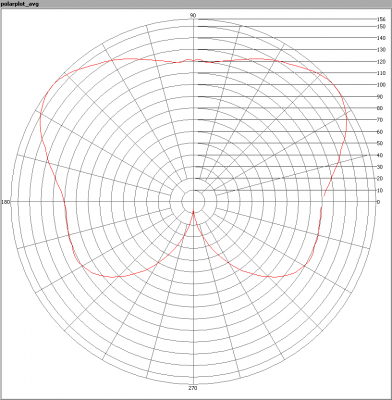
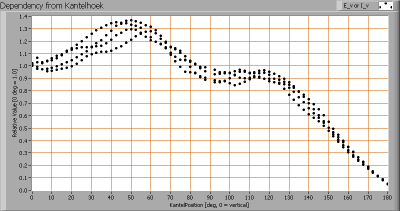
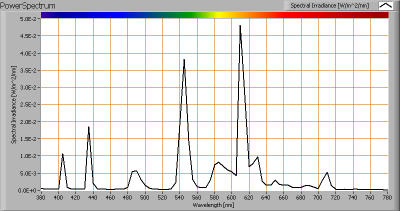
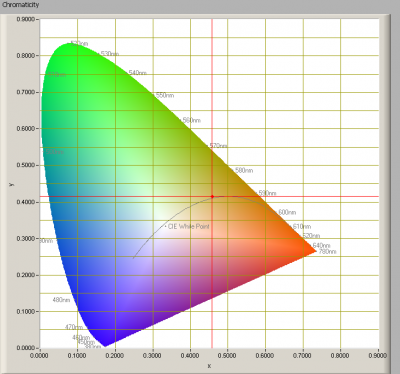
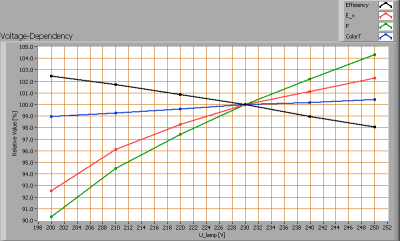
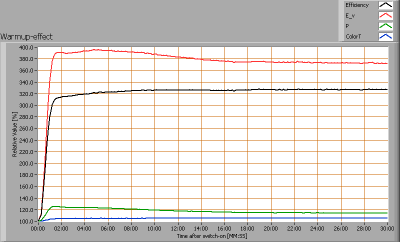
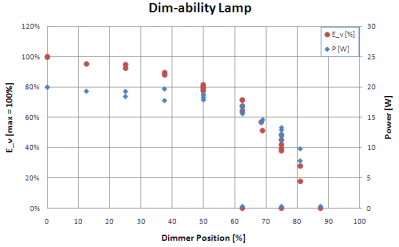



Most popular posts